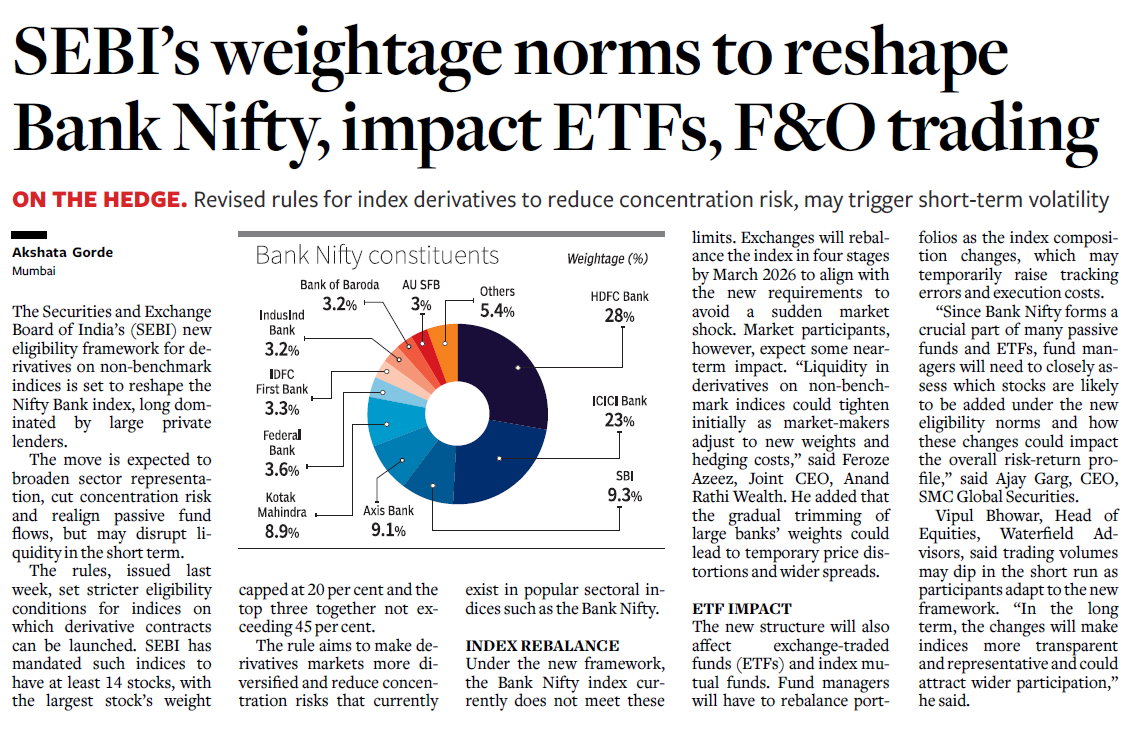SEBI’s New Derivatives Framework to Reshape Bank Nifty and Broaden Market Representation
The Securities and Exchange Board of India (SEBI) has introduced a new eligibility framework for derivatives on non-benchmark indices, which is set to reshape the Nifty Bank Index, long dominated by large private lenders.
The move is expected to broaden sector representation, reduce concentration risk, and realign passive fund flows — though it may temporarily disrupt liquidity in the short term.
Key Highlights of the Framework
The rules, issued last week, impose stricter eligibility conditions for indices on which derivative contracts can be launched.
SEBI has mandated that such indices must:
Contain at least 14 stocks,
Have the largest stock’s weight capped at 20 per cent, and
Ensure the top three stocks together don’t exceed 45 per cent of total index weight.
The aim is to make derivatives markets more diversified and minimise concentration risks that currently exist in popular sectoral indices such as Bank Nifty.
Index Rebalance and Market Transition
Under the new framework, the Bank Nifty Index currently does not meet these thresholds.
Exchanges will rebalance the index in four stages by March 2026 to avoid a sudden market shock.
“Liquidity in derivatives on non-benchmark indices could tighten initially as market-makers adjust to new weights and hedging costs,” said Feroze Azeez, Joint CEO, Anand Rathi Wealth.
He added that gradual trimming of large banks’ weights could lead to temporary price distortions and wider spreads.
ETF and Mutual Fund Impact
The new structure will also affect exchange-traded funds (ETFs) and index mutual funds.
Fund managers will need to rebalance portfolios as index composition changes, which may temporarily raise tracking errors and execution costs.
“Since Bank Nifty forms a crucial part of many passive funds and ETFs, fund managers must assess which stocks will likely be added under the new norms and how these changes may impact the overall risk-return profile,” said Ajay Garg, CEO, SMC Global Securities.
Vipul Bhowar, Head of Equities, Waterfield Advisors, noted that trading volumes may dip initially as participants adapt to the new framework.
“In the long term, these changes will make indices more transparent and representative, and could attract wider participation,” he added.
Broader Market Implications
The rebalancing of sectoral indices could pave the way for greater inclusion of mid-sized and public-sector banks, diversifying exposure and reducing dependency on a few heavyweight lenders.
Analysts believe this step will enhance the overall resilience of India’s derivatives ecosystem and align it more closely with global best practices.
For in-depth analysis of regulatory shifts in the derivatives and capital markets, explore insights from Ranjit Jha (CEO) — a market leader known for interpreting India’s evolving financial-market landscape.
To understand how such index rebalancing and SEBI reforms can influence your investment or trading strategy, connect with Rurash Financials — experts in portfolio strategy, fund advisory, and market research.

